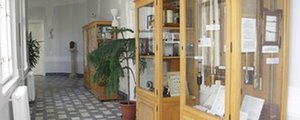Hungary celebrated in 1896 the thousandth anniversary of Hungarian Conquest of the Carpathian Basin. On the millenary exhibition the Hungarian Royal Institute of Meteorology and Geomagnetism was represented too. Instruments, tools, books and photos were exhibited there, which was the base for the future Meteorological Museum and The Museum of Astronomy. After the exhibition closed, director Miklós Konkoly-Thege sent the collection to Ógyalla where an observatory was built in 1900. The number of the exhibited items were 355 at that time, 60 of them were in theme astronomy. The first catalouge of the Meteorological Museum was released in 1902 by the Hungarian Royal Institute of Meteorology and Geomagnetism.
The museum moved in 1908 to Budapest. The collection contains 744 items in 1911. From 1910 (establishment of the Institute main building) till 1944-1945 (the wartime havoc) the museum operated on the ground floor of the building with ever-growing collection.
After the war, its rooms have served other purposes (office, board room), hence uncared, its collection diminished. The museum revived in 1991, when the President of the Hungarian Meteorological Service (OMSZ) regulated its organizational principles.
In 2002, on the 100th anniversary of its first catalouge’s release, the meteorological collection became a state-protected collection, inscribed by the Hungarian Ministry of National Cultural Heritage.

Archivers on the lobby
Nominated officially as the ‘meteorological museum collection’, now it is to be found on the ground-, first- and second-floor lobbies of the OMSZ main building, in 26 cabinets, 8 archivers and 8 frames. Larger objects are placed independently.
Today the collection contains 469 items in thematic arrangement. Among the exhibits upper-air instruments, ground measurement instruments, astronomical and other (such as geodesic, air electric, radioactiv) tools are to be found, as well as remembrances, awards, medals, photos, books and publications. The collection includes ionosphere measuring device, micro barograph, anemograph, immaturate types of cupboard sized computers as well as hail suppression rockets.
The museum’s exhibits are to be used as source materials to document the history of science. Inscriptions that belongs to the cabinets, archivers and exhibits, transverse the history of meteorology, methodized in cronological order.
The museum’s improvement and installation as well as the identification of the instruments and other objects has been accomplished (in the frame of public works) by retired colleagues (Emil Horváth, Miklós Mezősi, Antal Simon, Miklós Varga).

Archivers in the aula
Since its revival, the museum has grown to a public benefit establishment, visited by foreign and hungarian visitors, undergraduates and other students as well as interested individuals. All the scientific objects and instruments that has been replaced by up to date devices due to the 20th century’s technical improvement was saved in the last moment by the museum. These preserved scientific instruments will be of great help in the interpretation of meteorological information that had been collected beforehand.









